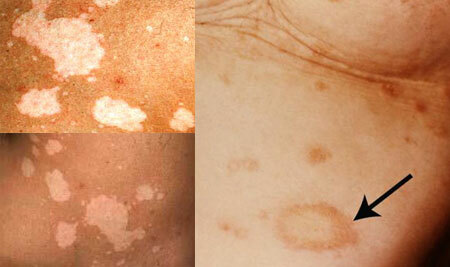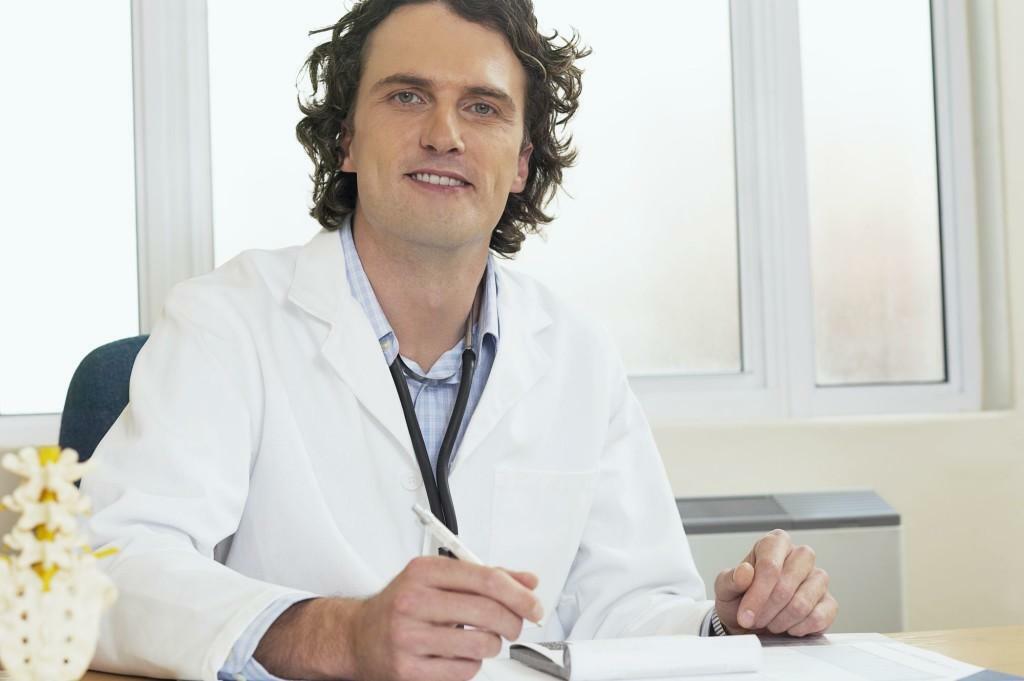What is it? Pityriasis is a chronic form of a fungal infection parasitizing on the upper layer of the epidermis. In everyday speech, it is called sunshine, as it becomes aggravated during the period of intense activity of ultraviolet radiation.
Pityriasis is a flaky speck of light yellow to brownish color. The causative agents of the disease are the fungi Pityrosporum, which exist in a round, oval and mycelial form. A person is the carrier of at least one of these species of fungus, but in most lichens this can never occur.
For the health of the disease is not dangerous, but aesthetic beauty in its form is small. Treatment of pityriasis may take a long period of time.
So, getting rid of it this summer, there is a possibility of the appearance of unpleasant spots in the following.

photo of pityrious lichen( all photos below)
Often pungent lichen is localized in the upper part of the trunk, which spends most of its time under ultraviolet rays. The most common spots on the neck, above the chest, on the shoulders and head. Hair follicles are not an obstacle to the location of fungal organisms. On the surface of the spots, the skin can peel and eventually change the shade.
The causes of the appearance of the rudimentary are:
- hereditary pathology;
- is a diabetes type and Cushing's syndrome;
- pregnancy and hormonal imbalances;
- oncological diseases;
- tuberculosis;
- excessive persistent sweating;
- excessive use of antibacterial agents;
- private stress and emotional disorders;
- visit to the beach or solarium.
Based on the list of causes of impairment, we can conclude - the fungus manifests itself in the fall of immunity, caused by hormonal failures and serious illnesses. The probability of transferring solar deprivation from mother to child is very high, but from the father the fungus can not be transmitted.
In addition to the hereditary path, it is possible to get infected with pityriasis by close contact with an infected person or his clothes. The danger also lies in the use of common household items. However, most likely, if you have a strong immune system, the fungus will not clinically manifest itself. But to hope for it is not necessary - it is necessary to adhere to preventive measures.
Contents
- 1 Symptoms of pityriasis in a person, photos
- 2 Pityriasis in children
- 3 Treatment of pityrious lichen - ointments and preparations
- 4 Treatment of pityriasis at home
- 4.1 Forecast
Symptoms of pityriasis in a person, photos of

stains may look different, photo
Typical symptoms of pityriasis in humans are:
- Appearance of pink spots with a yellowish color;
- Gradual change of their color to brown pigmentation, localized in typical places( in the first place, this is the decollete zone);
- Minor small-plate peeling of the appeared rashes on the skin;
- An irregularly observed pruritus of spots that does not differ in strong intensity;
- Skin does not burn in the place where the rash was localized. This is due to the functional inferiority of melanocytes - skin cells that produce pigment.
To determine if you really are suffering from sun damage, visit a dermatologist. The doctor will check your skin with a lamp - the fungus has luminescent properties. If the skin lights up in pink or greenish blue, the dermatologist diagnoses herpes.
In humans, the symptoms of pityriasis, in the form of itching and burning, are often not expressed. If the doctor is suspected of having a fungus-causative agent, he will send the patient to the analysis of cornified skin scales.
Odruvidny deprive in children

Children are most often infected because they have no primary knowledge of hygiene yet. After playing with a sick animal or another child, the risk of getting pityriasis is very great.
Children's immunity is hard to fight with an aggressive fungus, but they tolerate it more easily than adults. The risk of infection is also in adolescents due to sudden changes in the hormonal background and the constant stresses to which they are exposed.
Just like in adults, pityriasis deprives the child in no way showing itself, except for visual changes. At first, the mother may notice small convex pink dots.
At this stage, the disease is most easily treatable. In the future, the spots will change color first to yellow, and then to a brown shade.
Everything to which the child's body touches, it is necessary to individualize for a while. A growing organism is easier to cure, but parents risk later, if not to take preventive measures, to face unpleasant peeling spots every vacation.
- Treatment for children and adults is not fundamentally different.
Treatment of pityriasis - ointments and preparations

Treatment of pityriasis in a person does not require hospitalization and constant monitoring. In the most neglected cases, the dermatologist prescribes a course of antibiotics from the group of antimycotics( antifungal agents).The rest will get rid of the sunny lichen obtained with the help of ointments.
However, an immediate result should not be expected, since the fungus is removed only by prolonged and systematic treatment of foci on the skin.
The action of the active ingredients is aimed at softening and peeling off the upper stratified corneum of the skin, thereby directly removing the pungent lichen. To treat pityriasis lichen drugs are used in a complex - antimycotic and keratolic - to minimize the risk of relapse.
Consider the most common ones.
1. Mikozoral-ointment 2%
The basis of the drug "Mikozoral" is ketoconazole. This substance is effective in the fight against any fungal diseases( demorfitami - mushrooms, tropic to the skin).The action of Mycosoril in the form of an ointment is so strong that it can kill not only fungi, but also staphylococci, and streptococci, which can provoke a purulent process.
The drug is considered aggressive( but locally), but it is prescribed even to pregnant and breastfeeding women.
Ketoconazole has an effect similar to "burning", so Mikozoral contains oils and soothing ingredients. At first use in patients with sensitive skin, there is an itching or tingling sensation.
The effect after the application of "Mycosorrhal 2%" appears after 3-5 days, but treatment is often prescribed for 2 weeks or more to kill all fungal spores. In no case should you stop therapy, because, removing only the symptoms, the risk of repeated appearance of pityriasis is increasing.
If the case of a patient is started and one Mikozoralom can not be cured, a dermatologist is prescribed additional ointments or external application sprays. Apply any other remedy immediately after rubbing ketoconazole is prohibited, so you need to withstand a period of time of several hours. Optimal option is the use of ointments at different times of the day: morning and evening.
2. Clotrimazole-ointment
The most common form of ointment, but children prefer lotion or cream. The active substance is monotonous to the name of the preparation. Clotrimazole successfully fights with yeast-like fungi and some bacteria.
However, cases of immunity of fungi to this drug have been recorded, therefore, after the appointment of clotrimazole ointment, a repeated examination of the patient is necessary after 5-7 days, preferably with the use of fluorescent glow. If no positive results are found, the drug is replaced with a stronger one.
Clotrimazole is absorbed in small amounts through the skin, so it is not recommended for pregnant women who are in the first trimester of bearing a fetus. The next months to apply ointment on fungal foci is permissible up to the period of breastfeeding, tk.safety for milk in the laboratory was not proven.
"Clotrimazole" -meal is not used in combination with antibiotics, since it neutralizes the effect of some of them.
It is not permissible to closely adhere the tissues to the skin on which the ointment was applied for 4 hours. If the body reacts positively to clotrimazole, you can use ointment for extended periods without fear of allergic reactions.
3. Fungoterbine Ointment 1%
The active ingredient is terbinafine hydrochloride. The drug copes well with fungi at the initial stages of their development. Butylhydroxytoluene and carbamide, also included in the composition, contribute to the rapid regeneration of the skin, so the itching or burning after applying the drug are minimal.
"Fungoterbine" is not allowed to use for more than 14 days without interruption, however, its use is permissible for the prevention of the appearance of pityriasis.
Ointment is permissible for use in hair follicles - pungent lichen on the head is often localized if infection occurs as a result of direct contact with the patient.
4. Rumicosis tablets
"Rumikoz" is a preparation based on itraconazole, manufactured for internal use. The form of tablets is prescribed if local drugs can not cope with foci of fungal infection. The period of admission Rumikoza is made from a week to 28 days, depending on the results of treatment of pityriasis and re-examination data.
Itraconazole accumulates in the muscle tissue and remains there for a month after the end of taking the tablets."Rumikoz" is not recommended for pregnant and breastfeeding women. In addition, it is a risk for patients with diseases of the excretory system and the pathology of the liver in which it is metabolized.
To reduce harm to health, the tablets should be washed with acidic substances( kefir, lemon juice).
Treatment of pityriasis at home
It is permissible, but it is not recommended at the first detection of pityriasis, treatment at home. However, pregnant and breastfeeding women, young children and the elderly can be treated with homeopathic remedies and natural substances at home.
Popular solutions:
- Vinegar. This substance is recommended to lubricate the affected areas up to 5 times a day. The action of apple cider vinegar is to "burn" the scaly skin, thereby eliminating fungal foci.
- Decoction of buckwheat groats. Less aggressive means, but as practice shows, quite effective.10 minutes boil the buckwheat and the resulting solution to lubricate the stains 3-4 times a day.
- Boric acid( similar to vinegar).Pour a teaspoon of boric acid powder with a glass of boiling water and allow to cool. Wipe off the pityriasis once a day for 10 days.
- Tar is a proven method, but long in time. Within a month it is necessary to lubricate the affected area with dilute tar.
In addition to solutions, household ointments are also used for otarian hair loss based on herbs and pharmaceutical products:
- "Herbal" ointment. Take 2 tablespoons of crushed root of thistle and marigold flowers, add 15 cones of hops and pour a glass of water. Cook the ointment for at least 3 hours and then cool.
- Ointment based on St. John's wort - is made in two ways. First: dry St. John's wort is rubbed with Vaseline in a ratio of 1: 4.Second: the fresh St. John's wort is kneaded with tar in equal proportions - the ointments are ready.
- Ointment "oxalic".Chop the finely sorrel and season with thick cream until thick. This recipe thanks to the fat component contributes to the early recovery of the skin.
Well assisted in the treatment of pityriasis lichen decoctions of celandine, chinese and string. Prepare them in the following way: 3 tablespoons of dry or chopped fresh herbs pour 2 cups of boiling water, cook for 10 minutes and insist for half an hour after being removed from the fire.
For the restoration of the skin are useful oils of milk thistle, elder, lavender and rosemary. They smear stains at night to restore and soften the skin.
Forecast
If you follow the recommendations of a dermatologist and do not stop treatment with a weakening of symptoms, relapse after a few months can be avoided.
Folk recipes can also be used as the main treatment or prevention if they really help a person cope with the disease. But often, rational pharmacological therapy is required.
With the disappearance of the symptoms of pityrious lichen in a person after homeopathic remedies, they should be applied for another 7-10 days.



